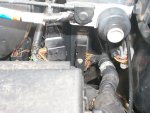ok, go back & get the codes checked again and come back;
to save your hard-earned $ & time, there are
different OBD II Codes for the diff. O2 sensors; such as:
P1128 -
Upstream Oxygen Sensors BEFORE CAT CONVERTER, below headers
P1129 -
Downstream Oxygen Sensors AFTER CAT CONVERTER between cat & muffler on one side, etc.
Ok, where are these *****'s? SEE FORD TSB 01-9-7
DRIVEABILITY - HO2S (HEATED OXYGEN SENSOR), CATALYST, AND FUEL SYSTEM MONITORS - SERVICE TIPS - OBD II VEHICLES ONLY
1996 BRONCO & many other types
http://v8sho.com/SHO/TSB0197HO2SServiceTips.htm
see figures in TSB for locations:
http://v8sho.com/SHO/images/TSB/T10907usen...a.gifgenref.gif
-----------
Some codes NOT LIKELY but I figured, what the heck? & possible causes for you since we'll be away for awhile:
P1130 - Lack of HO2S-11 Switch
Short to VPWR in harness or HO2S
Water in harness connector
Open/Shorted HO2S circuit
Corrosion or poor mating terminals and wiring did you ck the connector contacts?
Damaged HO2S
P1129 - Downstream Oxygen Sensors Swapped from Bank to Bank (HO2S-12-22) The HEGO monitor checks and determines if the HO2S signal response for a fuel shift corresponds to the correct engine bank. The test fails when a response from the HO2S(s) being tested is not indicated. Crossed HO2S harness connectors (downstream).
Crossed HO2S wiring at the harness connectors (downstream).
Crossed HO2S wiring at the 104-pin harness connectors (downstream).
P1131 - Lack of HO2S-11 Switch, Sensor Indicates Lean A HEGO sensor indicating lean at the end of a test is trying to correct for an over-rich condition. The test fails when the fuel control system no longer detects switching for a calibrated amount of time. See Possible Causes for DTC P1130
P1132 - Lack of HO2S-11 Switch, Sensor Indicates Rich A HEGO sensor indicating rich at the end of a test is trying to correct for an over-lean condition. The test fails when the fuel control system no longer detects switching for a calibrated amount of time. See Possible Causes for DTC P1130
P1137 - Lack of HO2S-12 Switch, Sensor Indicates Lean The downstream HO2S sensors are forced rich and lean and monitored by the PCM. The test fails if the PCM does not detect the output of the HO2S in a calibrated amount of time. Pinched, shorted, and corroded wiring and pins
Crossed sensor wires NOT LIKELY
Exhaust leaks
Contaminated or damaged sensor
P1138 - Lack of HO2S-12 Switch, Sensor Indicates Rich See DTC P1137
P1150 - Lack of HO2S-21 Switch, Fuel Trim at Limit See DTC P1130
P1151 - Lack of HO2S-21 Switch, Sensor Indicates Lean A HEGO sensor indicating lean at the end of a test is trying to correct for an over-rich condition. The test fails when fuel control system no longer detects switching for a calibrated amount of time. See Possible Causes for DTC P1130
P1152 - Lack of HO2S-21 Switch, Sensor Indicates Rich A HEGO sensor indicating rich at the end of a test is trying to correct for an over-lean condition. The test fails when the fuel control system no longer detects switching for a calibrated amount of time. See Possible Causes for DTC P1130
P1157 - Lack of HO2S-22 Switch, Sensor Indicates Lean See DTC P1137
P1158 - Lack of HO2S-22 Switch, Sensor Indicates Rich See DTC P1137
P0141 - HO2S Sensor Circuit Malfunction (HO2S-125) See DTC P0135
P0151 - HO2S Sensor Circuit Out of Range Low Voltage (HO2S-21) See DTC P0131
P0153 - HO2S Sensor Circuit Slow Response (HO2S-21) See DTC P0133.
P0155 - HO2S Sensor Circuit Malfunction (HO2S-21) See DTC P0135
P0156 - HO2S Sensor Circuit Malfunction (HO2S-22) See DTC P0136
P0161 - HO2S Sensor Circuit Malfunction (HO2S-22) See DTC P0135
P0171 - System to Lean (Bank 1) The Adaptive Fuel Strategy continuously monitors fuel delivery hardware. The test fails when the adaptive fuel tables reach a rich calibrated limit. For lean and rich DTCs:
etc
-----------
& some non-"bad parts" codes that has caused grief for many folks as well as non-informed (I'm being kind here) "technicians"
P1127 -
Exhaust Not Warm Enough, Downstream Sensor Not Tested The HEGO monitor uses an exhaust temperature model to determine when the HO2S heaters are cycled ON. The test fails when the inferred exhaust temperature is below a minimum calibrated value. Engine not operating long enough prior to performing KOER self-test.
Exhaust system too cool.

